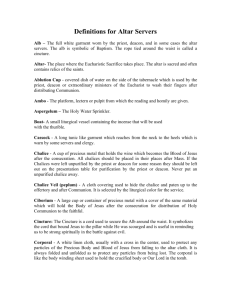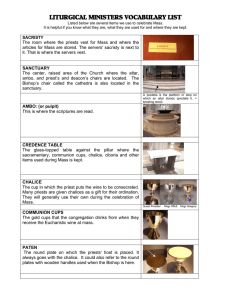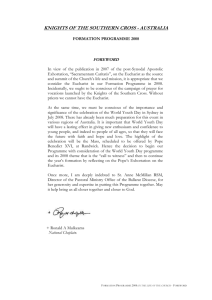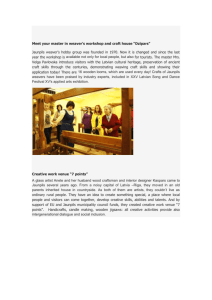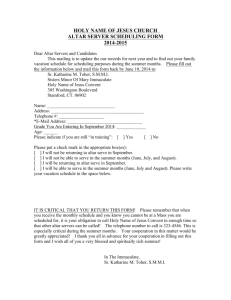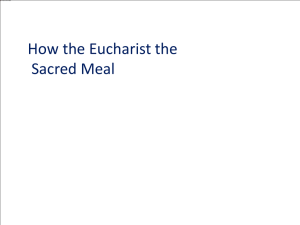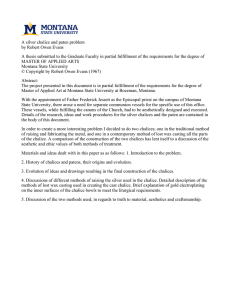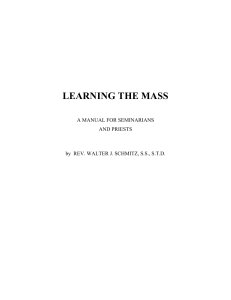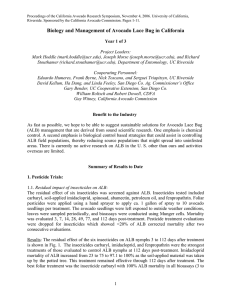Chalice - wikipersson
advertisement
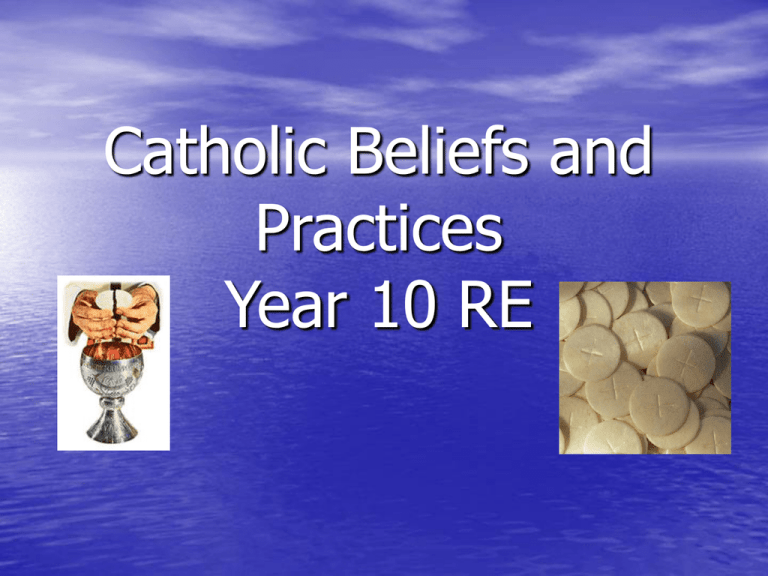
Catholic Beliefs and Practices Year 10 RE Chalice A cup into which the priest pours the wine and a few drops of water that will be changed into the Precious Blood of Christ Chalices have been used since the early church. Because of Jesus' command to his disciples to "Do this in remembrance of me." (Luke 22:19), and Paul's account of the Eucharistic rite in 1 Corinthians 11:2425, the celebration of the Eucharist became central to Christian liturgy. Naturally, the vessels used in this important act of worship were highly decorated and treated with great respect. Chalices are often made of precious metal, and they are sometimes richly enamelled and jewelled. Cruets A cruet is a small container used to keep wine and water during the celebration of Mass. They are usually made of glass, though sometimes they are made of precious metals such as gold or silver. Cruets comes in pairs, one to contain water and one to contain Altar Wine. These two liquids are mingled together in the chalice during the Eucharist in commemoration of the Last Supper. Ciborium A chalice-like vessel used to contain the Blessed Sacrament The eucharistic container takes its name from its cover, surmounted by a cross or other sacred design. In the early Christian Church, Holy Communion was not kept in churches for fear of sacrilege or desecration. Later, the first ciboria were kept at homes to be handy for the Last Rites where needed. In churches, a ciborium is usually kept in a tabernacle Paten The Eucharistic vessel known as the paten is a small shallow plate or disc of precious metal upon which the element of bread is offered to God at the Offertory of the Mass, and upon which the consecrated Host is placed. Chalice, Purificator & Paten with Host Corporal Corporal (from the Latin corpus, "body") is a square white linen cloth, now usually somewhat smaller than the breadth of an altar, upon which the chalice and paten, and also the ciborium containing the smaller hosts for the Communion of the laity, are placed during the celebration of the Eucharist (Mass). Stole The stole is the vestment that marks recipients of The Sacrament of Holy Orders. It is conferred at the ordination of a deacon, by which one becomes a member of the clergy. For the celebration of the Mass, the Priest wears the stole over the alb but under the chasuble. Likewise, the deacon wears the stole over the alb but under the dalmatic. Alb An Alb is an garment of white linen coming down to the ankles and usually girded with a cincture. It is simply the long linen tunic used by the Romans of old. It is a symbol of purity A Deacon wearing an alb and stole (as a sash) Purificator The purificator should be a piece of white linen, about 8 to 12 inches square (or three times the width of the chalice), with a small cross in the centre. Purificators are used to clean the chalice, by wiping the rim of the chalice with the purificator. Purificators mean to “Make Pure”. Amice The amice is a liturgical vestment consisting of a white cloth connected to two long ribbon-like attachments, by which it is fastened around the shoulders of the priest. Before the liturgical reforms of 1972, its use was mandatory for all Roman Catholic Masses, but it is only required today if the alb does not cover the priest's ordinary clothing. Cincture The cincture is a long, rope-like cord with tassled or knotted ends, tied around the waist outside the alb. The colour may be white, or may vary according to the colour of the liturgical season. Besides its functional role in securing the alb and stole, the cincture bears a symbolic rôle, signifying chastity and purity Ambo or Lectern The Ambo or Lectern is a platform or stand (made usually of wood, stone or metal), from where the readings, Gospel and homily are proclaimed to the congregation. Altar The altar is a table made of stone or wood is the place from which the Liturgy of the Eucharist is conducted. The doctrine of Christ's substitutionary atonement allowed the Christian celebration of the Last Supper - the Eucharist - to be seen as a memorial of Christ's sacrifice. In Catholic theology it is a re-presentation, in the literal sense of the one sacrifice being made "present again." Hence, the table upon which the meal (the bread and the wine) is prepared came to be seen as an altar. Tabernacle The Catholic Church holds the doctrine of transubstantiation: i.e., that Christ is "truly present, Body and Blood, Soul and Divinity," though under the appearance of bread, or of bread and wine. This presence perdures after the consecration, so that even after Mass is concluded, the Eucharistic elements are still Christ's Real Presence. A tabernacle therefore serves as a secure place in which to store the Blessed Sacrament for carrying to the sick who cannot participate in Mass or to serve as a focus for the prayers of those who visit the church. A light burns near the tabernacle when the Eucharist is present as a sign to members of the congregation. Sanctuary The area around the altar is considered holy because of the physical presence of God in the Eucharist, both during the Mass and in the tabernacle on the altar the rest of the time. So that people could tell when Jesus was there (in the tabernacle), the "sanctuary lamp" would be lit, indicating that anyone approaching the altar should genuflect (bow by bending the knee and inclining the head), to show respect for Him.
